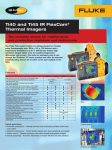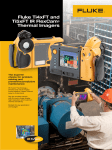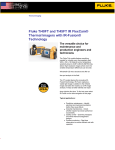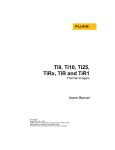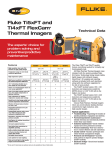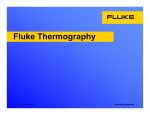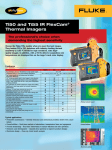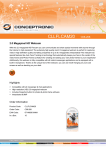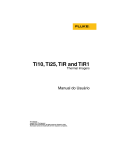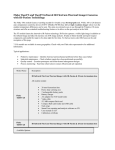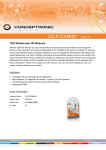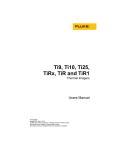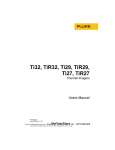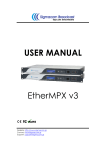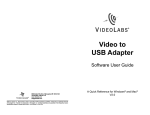Download Distributor Training Program Thermal Imaging
Transcript
Thermal Imaging Distributor Training Program Product Knowledge Thermal Imaging Thermal Imaging is the science of using thermal cameras to help us locate problems in their early stages, often before they can be seen or found in any other way. What is infrared thermography? Non-contact infrared imagers provide fast, safe, accurate measurements for objects that are: • Moving or very hot • Difficult to reach • Impossible to shut-off • Dangerous to contact • Where contact would damage, contaminate or change temperature Product Knowledge Thermal Imaging Discovery of the infrared spectrum Thermal cameras are instruments that create pictures of heat rather than light. They measure infrared (IR) energy and convert the data to corresponding images of temperature. A temperature difference, usually an abnormal hot spot, is typically associated with a problem due to high electrical resistance or excessive friction. On March 13, 1781, while scanning the skies with a 7-inch reflecting telescope, Friedrich Wilhelm Herschel, better known as Sir William Herschel (1738 – 1822), observed an unusual object. Thinking he had discovered a comet, it soon became apparent he was looking at a planet never before seen, Uranus. In his continuing search for an optical filter material to reduce the sun’s image in telescopes during solar observations, he discovered infrared radiation. By passing sunlight through a prism and holding a thermometer just beyond the red end of the visible spectrum, he observed a temperature increase confirming the existence of an invisible form of light known today as infrared wavelengths. Heat transfer The look, feel and operation of thermographic cameras are similar to a digital camera with one key difference, instead of CCD sensors (chargecoupled device); most thermal imaging cameras today use microbolometer arrays. Their resolution is considerably lower than digital cameras, commonly only 160 x 120 or 320 x 240 pixels. When looking for a thermal imager, select one that is fully radiometric. This means that each pixel is recording temperature values, which can be recalled later in software. Page Fluke Corporation FACT – Product Knowledge When there is a temperature difference between two objects, or when an object changes temperature, heat energy moves from the warmer areas to the cooler ones until there is thermal equilibrium. Heat energy moves to the surface, and then to our camera, by a complex, dynamic means that may include: conduction, convection and radiation. What you will learn in this module: • What is infrared thermography? • Discovery of the Infrared Spectrum • Heat transfer • Thermal Imaging Applications Conduction is direct heat flow through mat- ter resulting from actual PHYSICAL CONTACT. wind blowing across a surface making it appear cooler than its actual temperature. Radiation is the transmission of electromagnetic rays through space at the speed of light (186,000 miles/second) and like radio waves, is invisible. Product Knowledge Thermal Imaging For instance, if one end of an iron rod is heated, the heat travels by conduction through the metal to the other end. Fourier’s Law (named after the French physicist Joseph Fourier) describes this phenomenon, known as conduction heat transfer. Each material that has a temperature above absolute zero (-460°F) emits infrared radiation, including the sun, icebergs, stoves or radiators, humans, animals, furniture, ceilings, walls, floors, etc. Convection is the transport of heat within a gas or liquid. Warm air, such as smoke, rises while colder air sinks; the same is true for liquids, cold fluids being less buoyant tend to sink. In addition, as liquids evaporate, they draw heat energy from their surroundings, something to keep in mind when imaging a surface. Newton’s Law of Cooling states that for a body cooling in a draft (i.e., by forced convection such as the wind blowing), the rate of heat loss is proportional to the difference in temperatures between the body and its surroundings. A 10 mph wind can reduce the temperature difference by up to 1/2. A 15 mph wind can reduce the delta temperature by up to 2/3. Bottom line, always consider the effect of Page Fluke Corporation FACT – Product Knowledge Infrared radiation is just one form of electromagnetic radiation. Gamma rays, X-rays, ultraviolet, visual light, and radio wave are also forms of electromagnetic radiation. The only difference among them is their wavelength and the quantity of energy they transfer. The art of thermography involves an understanding of surface properties and their ability to give up or reflect thermal energy. Radiation is neither transmitted, absorbed, or reflected perfectly by any material. Two or three phenomena are occuring at once, and together must add up to the whole. As an example, we can see through a window (transmission) but we can also see reflections in the window at the same time. We also know that glass absorbs a small portion of the radiation because the sun heats the glass itself. For a typical window, 90% of the light radiation is transmitted, 7% is reflected and 3% is absorbed. The image of the iron shows a highly emissive dark coated surface on the left compared to a highly polished surface on the right. The apparant temperature of the coated side is over 340°F, while the highly polished, reflective side appears to be under 135°F. buss bars difficult. Emissivity depends on factors such as surface material, temperature, emission angle, and wavelength. Imaging a surface below .6 emissivity is not recommended. Product Knowledge Thermal Imaging Applications Electricians and maintenance technicians locate overheating joints and conductors, a telltale sign of their failure, to eliminate potential hazards. Building construction technicians can see heat leaks, where thermal insulation becomes faulty, to improve the efficiencies of HVAC systems. Firefighters use thermal imagers to see through smoke, find persons, and localize hotspots of fires. Thermal imaging cameras are installed in many luxury cars to aid the driver with thermal detection in the dark to help avoid obstacles. The coated side has higher emissivity than the polished side. This means the coated side has higher efficiency as a radiator than polished reflective metal, and the metal has higher reflectivity than the coated side and is more efficient as an infrared mirror. Thus, the coated side will indicate the target temperature more closely. The polished metal may indicate the background temperature, or that which is reflected off the smooth surface, rather than the actual temperature of the surface of the iron. This is an extremely important concept. Thermographers see targets exhibiting this emissivity contrast behavior every day. It could be an insulated electric cable with a bare metal lug connections or aluminum bus bars. It could be a bare metal nameplate on a painted surface such as an oil filled circuit breaker or load tap changer. It could be a piece of electrical tape placed by the thermographer on the bus bar to enable a decent reading. The list is long. Emissivity (e) Emissivity is a measure of a material’s ability to absorb and radiate energy. It is calculated through the ratio of radiation emitted by a surface to the radiation emitted by a known material called a blackbody, at the same temperature. A true black body would have an e = 1, as close to a perfect emitter of thermal energy, while any real object would have e < 1. It is therefore a measure of a material’s ability to emit infrared energy. Materials are assigned an emissivity value between 0 and 1.0. Most organic materials such as paints, plastics, electrical tape, fabrics and food have an emissivity value near 0.95. The emissivity value of bare metals is considerably lower near 0 and considered thermal reflectors. This makes measuring shiny Page Fluke Corporation FACT – Product Knowledge Thermal Imaging Test your knowledge Product Knowledge 1. A temperature difference is typically associated with a problem due to _______ _____. A. high electrical resistance B. excessive friction C. both A and B D. neither A nor B 2. Heat energy moves to the surface, and then to the camera, by a complex, dynamic means that may include: A. conduction, convection and osmosis. B. metamorphosis. C. conduction, convection and capacitance. D. conduction, convection and radiation. 3. Conduction is direct heat flow ____________. A. within a gas or liquid. B. through matter resulting from physical contact. C. through space at the speed of light. D. None of the above 4. If an imager is ________________, each pixel is recording temperature values that can be recalled later in software. A. fully-radiometric B. automatic C. parabolic Thermal Imaging D. None of the above 1. C 2. D 3. B 4. A Chapter Summary What is Infrared Thermography? • Thermographers use thermal cameras to help locate problems in their early stages, often before they can be seen or found any other way • A temperature difference, usually an abnormal hot spot, is typically associated with a problem due to high electrical resistance or excesssive friction • A thermal imager that is fully radiometric records values from each pixel, which can be recalled later in software Heat Transfer • Heat energy moves from the warmer areas to the cooler ones until there is thermal equilibrium • Heat energy moves to the surface, and then to our camera, by a complex, dynamic means that may include: conduction, convection and radiation. • Conduction is direct heat flow through matter resulting from actual physical contact • Convection is the transport of heat within a gas or liquid • Radiation is the transmission of electromagnetic rays through space as the speed of light Emissivity and Reflectivity • Emissivity is a measure of a material’s ability to absorb and radiate energy • A true black body is close to a perfect emitter of thermal energy • Materials are assigned emissivity values between 0 and 1.0 • Most organic materials such as paints, plastics, electrical tape, fabrics and food have an emissivity value near 0.95 • The emissivity value of bare metals is considerably lower near 0 and considered thermal reflectors Thermal Imaging Applications • Electricians and maintenance technicians locate overheating joints and conductors, which often can be indicative of bigger electrical problems • Building construction technicians can see heat leaks, where thermal insulation becomes faulty, to improve the efficiencies of HVAC systems Page Fluke Corporation FACT – Product Knowledge Fluke.Not just infrared. Infrared you can use.™ Fluke Corporation PO Box 9090, Everett, WA USA 98206 For more information call: In the U.S.A. (800) 443-5853 or Fax (425) 446-5116 In Canada (800)-36-FLUKE or Fax (905) 890-6866 Web access: http://www.fluke.com ©2009 Fluke Corporation. All rights reserved. Printed in U.S.A. Phase 1, Module 4, Rev 2 Product Knowledge Thermal Imaging Find problems faster and reduce unplanned downtime with the ultimate tools for troubleshooting, preventive, and predictive maintenance Fluke offers a complete range of handheld thermal imagers, ranging from the popular and affordable Ti10 and Ti25 to the highprecision Fluke IR FlexCam® Series that delivers the largest and sharpest images in the industry. The Ti25 and Ti10 thermal imagers are designed for everyday troubleshooting, maintenance, and infrared inspection work whereas the IR FlexCam Series is designed for Predictive Maintenance (PdM) experts, process engineers, and consultants who need the best thermal imager available. Electro-mechanical equipment • Motors and pumps • Bearings, pulleys and belts Process monitoring • Process control equipment • Tanks, pipes, valves, steam traps and vessels Facility maintenance • HVAC systems • Buildings and roofs Built for the industry, Fluke Ti Series Thermal Imagers can carry out inspections anytime, anywhere and anyplace. In fact thermal imagers can be used anywhere temperature plays an indicating role. Some industry applications are: Electrical power distribution systems • Three-phase systems • Overhead power cables • Distribution panels • Fuses, wiring and connections • Power/utility Page Fluke Corporation FACT – Product Knowledge Thermal Imaging Other • Electronic design • And many more Ti25 and Ti10: The Ultimate tools for troubleshooting and maintenance The perfect tools to add to your problem solving arsenal. Built for tough work environments, these high-performance, fully radiometric imagers are ideal for troubleshooting electrical installations, electro-mechanical equipment, process equipment, HVAC/R equipment and others. The solution for industrial maintenance applications Product Knowledge • Fluke Ti25 and Ti10 imagers come with enhanced problem detection and analysis capabilities with IR-Fusion® Technology. Simply scroll through the different viewing modes quickly to better identify trouble areas in Full IR thermal, picture-in-picture, or automatic blend visual and thermal images. • Optimized for field use in harsh work environments. • Engineered and tested to withstand a 2 m (6.5 ft) drop—When was the last time you dropped a tool? • Withstands dust and water—tested to an IP54 rating. What you will learn in this module: • The product family • Features and benefits • IR-Fusion® Technology • SmartView® IR analysis and reporting software • Delivers the clear, crisp images needed to find problems fast. • Identify even small temperature differences that could indicate problems with excellent thermal sensitivity (NETD). • Intuitive, three-button menu is easy to use— simply navigate with the push of a thumb. • No need to carry pen and paper—record findings by speaking into the camera. Voice annotations can be recorded with every image you take. Voice comments are saved along with individual images for future reference (Ti25 only). • Everything needed to get started is included. • Adjustable hand strap for left-or righthanded use. • Manufactured in the U.S.A. Typical applications: • Preventive maintenance – Identify electrical and mechanical problems before they cause failure • Industrial troubleshooting – Use infrared to assist in the troubleshooting of system failures or equipment performance issues. • Process monitoring – Real-time observation to ensure efficient and safe operation • Power/ Utilities - inspection and analysis of substation equipment and transformers Ti40FT and Ti45FT IR FlexCam® Thermal Imagers • Industrial troubleshooting – Use infrared to assist in the troubleshooting of system failures or equipment performance issues. • Quality control – Examine prototypes and refine thermal management designs • Process monitoring – Real-time observation to ensure efficient and safe operation Product Knowledge Ti50FT and Ti55FT IR FlexCam® Thermal Imagers Thermal Imaging The professional’s choice for applications demanding the highest performance. Choose the Fluke Ti5x models when you need the best images. They feature 320 x 240 detectors with industry leading thermal sensitivity (≤ 0.05 ˚C NETD) for high resolution, ultra high-quality images. In addition, with a 60 Hz detector acquisition rate temperatures are displayed live on the large 5-inch diagonal color display. Typical applications: • Preventive maintenance – Identify electrical and mechanical problems before they cause failure • Predictive maintenance - trend equipment performance with infrared inspections over time to determine optimum maintenance and repair schedules, minimizing uplanned downtime • Power/utilities – Inspection and analysis of substations, transmission lines and equipment • Process monitoring – Real-time observation to ensure efficient and safe operation • Research and Development – Quantify heat patterns to improve product designs • Electronic design – Close up circuit board analysis Large, sharp thermal images The Fluke Ti4x models feature everything needed for virtually every thermography task. With a 160 x 120 detector and a temperature sensitivity to 0.08 °C (NETD) they deliver high resolution images where even the smallest temperature differences can be seen. The units are extremely easy to use through the Windows® CE menu structure and offer an extended troubleshooting feature set to allow on the spot analysis in the field. NETD stands for Noise Equivalent Temperature Difference. Bottom line, the lower the spec the greater the thermal sensitivity. Typical applications: • Preventive maintenance – Identify electrical and mechanical problems before they cause failure Page Fluke Corporation FACT – Product Knowledge Thanks to the largest display (five inch) available on this type of thermal imager in combination with low-noise VOx sensors, the Fluke IR FlexCam units produce exceptionally high-quality images making even the smallest temperature differences visible. This is comparable with images normally only obtained on far more expensive instruments. A sharp image in every situation The innovative 180° articulating lens makes it possible to view and capture images in areas with poor accessibility. The display remains clearly visible while viewing over high objects, under a machine or around immoveable obstructions. The SmartFocus lens simplifies getting a stable and sharp image. IR-Fusion® Technology Infrared and visible light images fused together on one display See things both ways—infrared and visual (visible light) images fused together communicating critical information faster and easier—traditional infrared images are no longer enough. Fluke led the way in the development and use of IR-Fusion and the industry followed. Both visible and infrared images allow you to communicate exactly where potential savings can be gained. IR-Fusion is standard on most Fluke thermal imager models. Make anomalies visible Thanks to built-in functions like AutoCapture, the IR FlexCam Thermal Imagers help to troubleshoot difficult problems. The instrument is easily set up to automatically capture only those images where a temperature limit is exceeded. This way, difficult to find intermittent problems can be captured and analyzed quicker by concentrating only on the images containing the anomalies. Analysis and reporting comes standard The SmartView® software (supplied with the unit) includes a complete range of infrared image viewing, analysis, annotation and optimization tools. It even allows for the creation of professional reports that can be customized to accommodate specific company requirements like layout, formatting, and content. Sharp, high-resolution thermal images The Fluke IR FlexCam is available with different detector sizes, temperature ranges and thermal sensitivities to meet every image quality requirement. All Fluke thermal imagers are fully radiometric. Measurement data for thousands of individual sensor points are stored. All these data points can be used for analysis and reporting on the imager or in the software supplied with each instrument. 5 viewing modes* Full IR – For troubleshooting and analyzing equipment and installations with very high resolution IR imaging. For detecting the smallest temperature variations to track down the origin of problems and fully document the extent of remediation. Full IR images are automatically linked to full visible light images. Picture-in-Picture – For creating an IR ’window’ surrounded by a visible light frame to easily identify thermal anomalies, while maintaining a frame of reference with surroundings. Alpha Blending – For combining visible and infrared images together in any ratio to create a single image with enhanced detail that will help in precisely locating problems. IR/Visible Alarm – For displaying only temperatures that fall above, below, or in between a specified range as IR image, leaving the rest of the scene as a fully visible light image. Full Visible Light – A bright, detailed pixelfor-pixel reference image of subject areas for documentation and reporting. *Not all models have all viewing modes. Please consult technical data sheets for specific information. The real power behind IR-Fusion is the SmartView® software. Capture and annotate hundreds of corresponding visible and infrared images in the field and quickly import them into the SmartView suite. Here, the images can Page Fluke Corporation FACT – Product Knowledge Product Knowledge Thermal Imaging be optimized for maximum communication value—adjusting imagery within IR-Fusion’s five display modes—perform sophisticated analysis, and produce professional reports quickly and easily. SmartView’s comprehensive reporting tools are fully customizable. Fluke SmartView® IR analysis and reporting software Fluke SmartView software is included with each Fluke thermal imager. This powerful software is a modular suite of tools that annotates, views, optimizes and analyzes IR images. It also generates fully customizable and professional-looking reports in a few easy steps. The IR-Fusion® technology is fully supported. The software is easy to use for maintenance personnel, yet delivers the performance specialized thermographers require for advanced analysis and reporting. Simplified report generation • Generate professional customized reports fast • One-click report generation for a quick result • Choice of features including before/after, IR plus visible light, annotations, supporting data and graphics • Report wizard guides the user through report generation “You don’t need to be a computer genius to get the most out of SmartView software.” Image viewing and editing • Displays an array of open images for convenient selection and analysis • A simple mouse click displays the temperature at any given point • Color palettes, reference images, markers and emissivity can be edited Extensive annotation possibilities • Add annotations to images in the camera or in the PC software • Input information such as locations, category and other notes • Reference images can be linked together for good/bad and before/after analysis • Annotations can be included in reports Detailed analysis and total image control • Contrast and detail can be easily adjusted to display more effectively by altering the palettes and adjusting level span • A complete set of marker tools are provided (Hot, Cold, Center Point, Center Box, etc.) • Five viewing modes enable image optimization based on application needs (IRFusion models only) Page Fluke Corporation FACT – Product Knowledge Chapter Summary Ti25 and Ti10 Thermal Imagers The Ti25 and Ti10 thermal imagers are the most rugged, reliable, and easy to use imagers in the market today. Equipped with IR-Fusion technology, they are the perfect tools for everyday industrial and commercial troubleshooting and maintenance activities. They come with everything you need to get started including: • AC power supply/battery charger (including mains adapters) • 2GB SD memory card • SD card reader (USB) for downloading images into your computer • SmartView® software with free software upgrades for life • rugged hard, carrying case • soft transport bag • hand strap • users manual • warranty registration card • interactive training DVD Product Knowledge Thermal Imaging Test your knowledge Product Knowledge 1. All Fluke imagers are _______________________________, the image and associated measurement data is stored for later analysis. A. fully radiotonic B. fully radiometric C. fully telemetric D. fully radiomasonic 2. The Fluke Ti50FT and Ti55FT IR FlexCam® Thermal Imagers are the professional’s choice when demanding the highest sensitivity because they feature: A. 320 x 240 detectors B. ≤ 0.05 ˚C NETD for high resolution C. a 60 Hz detector acquisition rate D. all of the above Thermal Imaging 3. IR-Fusion™ Technology _______________________________________________________. A. links a real world visual image with a thermal image. B. powers the instrument for years and years without batteries. C. holds the instrument together instead of screws. D. links voice recordings with thermal images. 4. Fluke SmartView™ IR analysis and reporting software is included with each Fluke thermal imager, license free, with the purchase of each imager. A. true B. false C. at an extra price D. don’t know 1. B 2. D 3. A 4. A Chapter Summary (continued) Ti40FT, Ti45FT, Ti50FT, Ti55FT FlexCam Thermal imagers The expert’s choice for problem solving and preventive/predictive maintenance. The Fluke Ti5xFT and Ti4xFT models feature everything needed for virtually any thermography task. All Fluke FlexCam Thermal Imagers come standard with the patent-pending Fluke IR-Fusion® Technology fusing visual (visible light) images with infrared images. • SmartView™ IR analysis and reporting software is included with each purchase along with free software upgrades for the life of your product. • The Ti4xFT models feature 160 x 120 detectors and temperature sensitivity (NETD) down to 0.08 °C (80 mK) in the higher end model. • The Ti5xFT models feature 320 x 240 detectors and temperture sensitivity (NETD) down to 0.05 °C (50 mK) in the higher end model. Choose Fluke FlexCam Thermal Imagers when you need industry leading thermal sensitivity for high resolution, ultra high-quality images. They come with everything you need to get started, including: • Heavy duty carrying case • 2 rechargeable battery packs • battery charger • ac adapter (for Ti45FT and Ti55FT only) • video cable • 1 GB compact flash card • compact flash card reader and USB cable • neck strap • printed getting started guide • SmartView reporting and analysis software on CD • complete user manual on CD Page Fluke Corporation FACT – Product Knowledge Fluke.Not just infrared. Infrared you can use.™ Fluke Corporation PO Box 9090, Everett, WA USA 98206 For more information call: In the U.S.A. (800) 443-5853 or Fax (425) 446-5116 In Canada (800)-36-FLUKE or Fax (905) 890-6866 Web access: http://www.fluke.com ©2009 Fluke Corporation. All rights reserved. Printed in U.S.A. Phase 3, Module 8, Rev 2 Fluke.Keeping your world up and running.® Fluke Corporation PO Box 9090, Everett, WA USA 98206 Fluke Europe B.V. PO Box 1186, 5602 BD Eindhoven, The Netherlands For more information call: In the U.S.A. (800) 443-5853 or Fax (425) 446-5116 In Europe/M-East/Africa +31 (0) 40 2675 200 or Fax +31 (0) 40 2675 222 In Canada (800)-36-FLUKE or Fax (905) 890-6866 From other countries +1 (425) 446-5500 or Fax +1 (425) 446-5116 Web access: http://www.fluke.com ©2009 Fluke Corporation. Specifications subject to change without notice. Printed in U.S.A 1/2009 FACT Distributor Training Program C-EN-N Rev A











